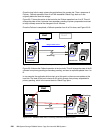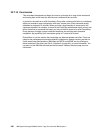302 IBM System Storage DS6000 Series: Copy Services with IBM System z
TSO commands
TSO commands are submitted using an inband approach over the host channel directly to the
storage disk subsystem. No active SMC or DS SM is required to trigger Copy Services
functions.
You can issue the TSO commands from procedures that are similar to the scripting approach
in open systems environments.
Note that TSO requires a z/OS system at the recovery site when you recover a Global Mirror
environment at the remote site.
DS CLI
The strength of DS CLI is its scripting capability. You can easily create and modify script files.
From a syntax level, the DS CLI looks a bit more complicated, and it tends to extend single
lines for single commands, which makes it harder to read when you have to maintain such
script files. Again, this may be a matter of experience.
ICKDSF
ICKDSF is the only direct interface for z/VM and z/VSE environments. It is also very quick,
just as the TSO commands are, because it does not need other components and networks
in-between to trigger Copy Services functions.
DS Storage Manager
The DS Storage Manager provides a Web-based graphical user interface (GUI), which
makes it friendly and user oriented. It is best suited for when you need to perform ad hoc
actions, and creating a script would be too time-consuming. It is not the best choice when you
have to set up a big and complex Global Mirror environment.
ANTRQST Macro
We do not cover the ANTRQST macro here. This macro is used by software automation
routines to provide full function management of Global Mirror. GDPS is an example.
Again, it is mostly your choice, depending on personal preferences and experience. When
you have no bias, we consider TSO commands the preferable interface for managing Global
Mirror in a z/OS environment. Through the inband approach over host channels and without
other agents in-between, TSO commands execute very quickly. The TSO command syntax is
also rather simple. TSO is an integral part of z/OS standard software, which stands for
reliability, availability, and serviceability.
24.3 Global Mirror management using TSO commands
TSO commands are commonly used in z/OS environments to manage remote copy
configurations. TSO commands may also be executed from REXX or CLIST procedures.
TSO commands have the advantage that they do not need a DS6000 SMC, nor an ad hoc
storage management server. They are directly forwarded, via an inband approach, to the
storage disk subsystem. This happens over the host channel connection, which usually is
FICON. This inband characteristic allows a very quick command transfer—it does not have to
go through software stacks in the storage server microcode.
When working with Copy Services, TSO commands generally use a z/OS device number to
aim for the device, LSS, or storage disk subsystem. Still, with Global Mirror, TSO commands
require an online VOLSER as a parameter.


















